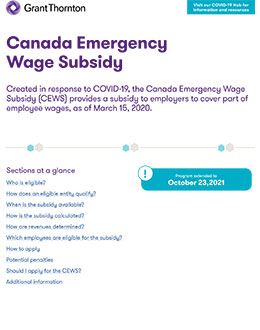-
Financial reporting and accounting advisory services
You trust your external auditor to deliver not only a high-quality, independent audit of your financial statements but to provide a range of support, including assessing material risks, evaluating internal controls and raising awareness around new and amended accounting standards.
-
Accounting Standards for Private Enterprises
Get the clear financial picture you need with the accounting standards team at Doane Grant Thornton LLP. Our experts have extensive experience with private enterprises of all sizes in all industries, an in-depth knowledge of today’s accounting standards, and are directly involved in the standard-setting process.
-
International Financial Reporting Standards
Whether you are already using IFRS or considering a transition to this global framework, Doane Grant Thornton LLP’s accounting standards team is here to help.
-
Accounting Standards for Not-for-Profit Organizations
From small, community organizations to large, national charities, you can count on Doane Grant Thornton LLP’s accounting standards team for in-depth knowledge and trusted advice.
-
Public Sector Accounting Standards
Working for a public-sector organization comes with a unique set of requirements for accounting and financial reporting. Doane Grant Thornton LLP’s accounting standards team has the practical, public-sector experience and in-depth knowledge you need.
-
Tax planning and compliance
Whether you are a private or public organization, your goal is to manage the critical aspects of tax compliance, and achieve the most effective results. At Doane Grant Thornton, we focus on delivering relevant advice, and providing an integrated planning approach to help you fulfill compliance obligations.
-
Research and development and government incentives
Are you developing innovative processes or products, undertaking experimentation or solving technological problems? If so, you may qualify to claim SR&ED tax credits. This Canadian federal government initiative is designed to encourage and support innovation in Canada. Our R&D professionals are a highly-trained, diverse team of practitioners that are engineers, scientists and specialized accountants.
-
Indirect tax
Keeping track of changes and developments in GST/HST, Quebec sales tax and other provincial sales taxes across Canada, can be a full-time job. The consequences for failing to adequately manage your organization’s sales tax obligations can be significant - from assessments, to forgone recoveries and cash flow implications, to customer or reputational risk.
-
US corporate tax
The United States has a very complex and regulated tax environment, that may undergo significant changes. Cross-border tax issues could become even more challenging for Canadian businesses looking for growth and prosperity in the biggest economy in the world.
-
Cross-border personal tax
In an increasingly flexible world, moving across the border may be more viable for Canadians and Americans; however, relocating may also have complex tax implications.
-
International tax
While there is great opportunity for businesses looking to expand globally, organizations are under increasing tax scrutiny. Regardless of your company’s size and level of international involvement—whether you’re working abroad, investing, buying and selling, borrowing or manufacturing—doing business beyond Canada’s borders comes with its fair share of tax risks.
-
Succession & estate planning
Like many private business owners today, you’ve spent your career building and running your business successfully. Now you’re faced with deciding on a successor—a successor who may or may not want your direct involvement and share your vision.
-
Tax Reporting & Advisory
The financial and tax reporting obligations of public markets and global tax authorities take significant resources and investment to manage. This requires calculating global tax provision estimates under US GAAP, IFRS, and other frameworks, and reconciling this reporting with tax compliance obligations.
-
Transfer pricing
Recognized as a leader in the transfer pricing community, our award-winning team can help you expand your business beyond borders with confidence.

-
Transactions
Our transactions group takes a client-centric, integrated approach, focused on helping you make and implement the best financial strategies. We offer meaningful, actionable and holistic advice to allow you to create value, manage risks and seize opportunities. It’s what we do best: help great organizations like yours grow and thrive.
-
Restructuring
We bring a wide range of services to both individuals and businesses – including shareholders, executives, directors, lenders, creditors and other advisors who are dealing with a corporation experiencing financial challenges.
-
Forensics
Market-driven expertise in investigation, dispute resolution and digital forensics
-
Cybersecurity
Viruses. Phishing. Malware infections. Malpractice by employees. Espionage. Data ransom and theft. Fraud. Cybercrime is now a leading risk to all businesses.
-
Consulting
Running a business is challenging and you need advice you can rely on at anytime you need it. Our team dives deep into your issues, looking holistically at your organization to understand your people, processes, and systems needs at the root of your pain points. The intersection of these three things is critical to develop the solutions you need today.
-
Creditor updates
Updates for creditors, limited partners, investors and shareholders.

-
Governance, risk and compliance
Effective, risk management—including governance and regulatory compliance—can lead to tangible, long-term business improvements. And be a source of significant competitive advantage.
-
Internal audit
Organizations thrive when they are constantly innovating, improving or creating new services and products and envisioning new markets and growth opportunities.
-
Certification – SOX
The corporate governance landscape is challenging at the best of times for public companies and their subsidiaries in Canada, the United States and around the world.
-
Third party assurance
Naturally, clients and stakeholders want reassurance that there are appropriate controls and safeguards over the data and processes being used to service their business. It’s critical.
-
 Assurance Important changes coming to AgriInvest in 2025AgriInvest is a business risk management program that helps agricultural producers manage small income declines and improve market income.
Assurance Important changes coming to AgriInvest in 2025AgriInvest is a business risk management program that helps agricultural producers manage small income declines and improve market income. -
 Tax alert Agricultural Clean Technology ProgramThe Agricultural Clean Technology Program will provide financial assistance to farmers and agri-businesses to help them reduce greenhouse gas (GHG) emissions.
Tax alert Agricultural Clean Technology ProgramThe Agricultural Clean Technology Program will provide financial assistance to farmers and agri-businesses to help them reduce greenhouse gas (GHG) emissions. -
 Tax alert ACT Program – Research and Innovation Stream explainedThe ACT Research and Innovation Stream provides financial support to organizations engaged in pre-market innovation.
Tax alert ACT Program – Research and Innovation Stream explainedThe ACT Research and Innovation Stream provides financial support to organizations engaged in pre-market innovation. -
 Tax alert ACT Program – Adoption Stream explainedThe ACT Adoption Stream provides non-repayable funding to help farmers and agri-business with the purchase and installation of clean technologies.
Tax alert ACT Program – Adoption Stream explainedThe ACT Adoption Stream provides non-repayable funding to help farmers and agri-business with the purchase and installation of clean technologies.
-
Builders And Developers
Every real estate project starts with a vision. We help builders and developers solidify that vision, transform it into reality, and create value.
-
Rental Property Owners And Occupiers
In today’s economic climate, it’s more important than ever to have a strong advisory partner on your side.
-
Real Estate Service Providers
Your company plays a key role in the success of landlords, investors and owners, but who is doing the same for you?

-
Mining
There’s no business quite like mining. It’s volatile, risky and complex – but the potential pay-off is huge. You’re not afraid of a challenge: the key is finding the right balance between risk and reward. Whether you’re a junior prospector, a senior producer, or somewhere in between, we’ll work with you to explore, discover and extract value at every stage of the mining process.
-
Oil & gas
The oil and gas industry is facing many complex challenges, beyond the price of oil. These include environmental issues, access to markets, growing competition from alternative energy sources and international markets, and a rapidly changing regulatory landscape, to name but a few.
Updated on September 9, 2021.
Created in response to COVID-19, the Canada Emergency Wage Subsidy (CEWS) provides a subsidy to employers to cover part of employee wages, as of March 15. The CEWS rules were revamped in July 2020 and again in November 2020.
Who is eligible for the CEWS?
The CEWS is available to employers that meet the definition of an “eligible entity”:
- An individual other than a trust (e.g., sole proprietorships)
- A taxable corporation
- A taxable trust
- A registered charity, other than a public institution
- A non-profit organization, other than a public institution
- A partnership, all of the members of which are described in points 1 through 5
- A prescribed organization
The term “public institution” is also defined and would include municipalities, local governments, Crown corporations (both federal and provincial), public universities or colleges, schools, school boards, hospitals and health authorities, among others.
Since the start of the pandemic, additional types of entities have been designated as prescribed organizations such that they are now eligible for the CEWS. These are:
- Indigenous businesses that meet certain criteria
- Partnerships where no more than 50% of the members are non-eligible entities
- Registered Canadian amateur athletic associations
- Registered journalism organizations
- Non-public education and training institutions, such as private colleges and private schools (e.g., arts schools, driving schools and culinary schools)
How does an eligible entity qualify?
Application
An eligible entity is required to file an application on CRA’s website (see application process details below). The application must include an attestation by the individual who has principal responsibility for the financial activities of the eligible entity that the application is complete and accurate in all material respects (this can also be done through a representative).
The application must be made by the later of:
- January 31, 2021, or
- 180 days after the end of the qualifying period.
Payroll account
When the rules were first introduced, they required an employer to have a payroll account set up as of March 15, 2020. However, changes were introduced that now allow an employer using third-party payroll providers (paymaster arrangements) to also qualify, provided the employer employed one or more individuals in Canada on March 15, 2020 and certain other criteria are met.
Decrease in revenues
When the CEWS was first introduced, it required a decrease in monthly revenues of at least 15% (March) or 30% (April and May) as compared to a prior reference period, either the same month of the prior year or an average of January and February 2020. Since then, the government has made key changes to this requirement.
As of June, new rules apply that no longer require the decrease in revenue to meet a specific threshold. Now, any drop in revenue will allow an employer to qualify for the wage subsidy, provided other requirements are met.
Depending on the choices made by the employer with respect to revenues, it could impact their ability to qualify for the subsidy. Considerations need to be made in the following areas:
- Revenue comparison: deciding which prior reference period to use for purposes of determining the drop in revenue
- Revenue calculation: entity-by-entity basis or consolidated
- Revenue calculation: cash method vs. accrual
- Revenue calculation: the effect of revenues from related parties
- Subsidy calculation: deciding which baseline remuneration period to use in the calculation of the wage subsidy
For more information, read the full PDF [ 355 kb ]
We are here to helpWe understand that you want to be agile and responsive as the situation unfolds. Having access to experts, insights and accurate information as quickly as possible is critical—but your resources may be stretched at this time. We’re here to support you as you navigate through the impacts of coronavirus on your business and your investments. |
[1] Specifically, the definition includes NPOs that are exempt from income tax due to paragraph 149(1)(e), (j), (k) or (l) of the Income Tax Act. Generally, this would include non-profit organizations, agricultural organizations, labour organizations, as well as others.
[2] Members of the partnership can also include other partnerships all of whose members are those noted in points 1-4, above
[3] This gives the government the flexibility to include other organizations that may have been unintentionally omitted.
Doane Grant Thornton LLP wants to caution that these rules are still new and continue to evolve as the government continues to re-evaluate the economic impact caused by the COVID-19 pandemic. We may still see changes to these measures—as well as new measures—as the government attempts to address the issues that have been raised by us and the tax community. Therefore, any analysis included herein reflects our knowledge as of the date and time of this publication and may no longer be applicable if changes do occur. You should proceed with caution before making any decisions.

